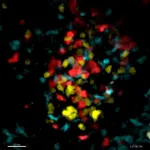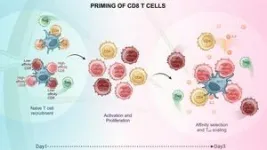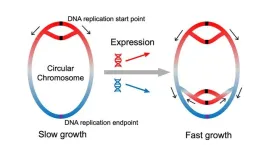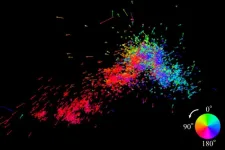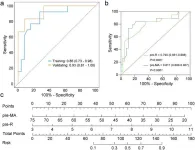(Press-News.org) The research groups led by Wolfgang Kastenmüller and Georg Gasteiger employed innovative microscopy techniques to observe how specific immune cells, known as T-cells, are activated and proliferate during a viral infection. Their findings revealed novel mechanisms: the immune system amplifies its defense cells in a far more targeted way than previously believed.
T-Cells Proliferate and Specialize During the Immune Response
T-cells are crucial defense cells in the immune system. To effectively find and destroy infected cells in the body, rare T cells with the appropriate specificity must first proliferate, expand and specialize. This process, known as T-cell priming, begins when T-cells encounter dendritic cells (DCs) in the lymph nodes. These cells present antigens - fragments of pathogens - to the T-cells and activate them through various signals.
The activation process lasts about 24 hours. During this time, T-cells remain in contact with the DCs, receiving instructions to specialize. Afterward, they detach, migrate, and rapidly proliferate. Some develop into effector cells that immediately combat pathogens, while others become memory cells, enabling a rapid response in case of future infections.
Only the Most Effective T-Cells Are Selected
The immune system faces the daunting task of swiftly identifying, from an extraordinarily diverse pool of T-cells, those that can specifically recognize a given pathogen. These selected T-cells are then clonally expanded during the "priming" process.
Katarzyna Jobin and Deeksha Seetharama are the first authors of the study. "We have discovered that T-cell activation involves not just one, but two distinct phases," explains Deeksha Seetharama. "While the first phase of priming serves to activate a broad range of specific T-cells, the newly identified second phase is responsible for selecting and specifically expanding those T-cells that can recognize the pathogen most effectively. This ensures that the immune response is optimized for maximum efficiency," Katarzyna Jobin elaborates.
"Until now, it was assumed that only one phase existed, with the initially activated cells continuing their function on ‘autopilot’," adds Wolfgang Kastenmüller. "What was previously unknown, however, was the process by which the best-suited cells are selected."
Findings Could Lead to Enhanced Therapeutic Approaches
The team found that the various phases of the immune response are driven by a cyclical activation process of T-cells. Following their initial interaction, T-cells undergo a period of desensitization, during which it takes two to three days before they are ready to perceive additional signals through their T-cell receptors.This marks the onset of the newly discovered second phase, in which they are re-instructed and further activated.
The scientists could show that in this second phase, T-cells re-cluster with DCs and get activated again to enhance their proliferation and specialization. This occurs in specific lymph node areas that are accessed thanks to CXCR3 expression on CD8 T cells. There, they receive IL-2 from CD4 helper T-cells. Without this signal, CD8 T-cells cannot proliferate optimally, which is why mainly CD8 T-cells with strong antigen binding dominate the second phase and are abundant at the peak of the immune response.
In chronic infections and cancer, there are recurring phases of activation and desensitization, which makes the findings particularly relevant for immunotherapies targeting cancer. This includes therapies used in certain leukemias and lymphomas, where the patient’s own T-cells are utilized. These cells are genetically modified in the laboratory and then reintroduced into the body through infusion. The modified cells, known as CAR T-cells, are designed to specifically recognize and attack cancer cells.
"We hope that our new insights will help deepen our understanding of how to optimize T-cell-based therapies, and that they will shed light on why these treatments sometimes fail," explains Georg Gasteiger.
The Max Planck Research Group
The Max Planck Research Group of Systems Immunology is a collaborative effort between the Julius Maximilian University of Würzburg (JMU) and the Max Planck Society (MPG) aimed at promoting excellent immunological research. Around 50 researchers from more than 20 countries are working together to understand the basis of a successful immune response against infectious agents, chronic inflammatory diseases, and tumors. Their goal is to develop new concepts and strategies for vaccines and immunotherapies.
To achieve this, the group is investigating the development and function of the immune system holistically at multiple levels. They are conducting high-resolution analyses of single molecules and cells, examining complex cellular networks within organs, and exploring systemic interactions in the body and with the environment. These research goals align well with the internationally visible research on infectious diseases and immunotherapies at the Würzburg Life Science Campus.
END
New phase of the immune response uncovered
2025-04-10
ELSE PRESS RELEASES FROM THIS DATE:
Drawing board rather than salt shaker
2025-04-10
Bioinformaticians from Heinrich Heine University Düsseldorf (HHU) and the university in Linköping (Sweden) have established that the genes in bacterial genomes are arranged in a meaningful order. In the renowned scientific journal Science, they describe that the genes are arranged by function: If they become increasingly important at faster growth, they are located near the origin of DNA replication. Accordingly, their position influences how their activity changes with the growth rate.
Are genes distributed randomly along the bacterial chromosome, as if scattered from a salt shaker? This opinion, which is held by a majority of researchers, has ...
Engineering invites submissions on AI for engineering
2025-04-10
Artificial intelligence (AI) is playing an increasingly pivotal role in revolutionizing the field of engineering, triggering a new era of technological and industrial evolution. A series of recent breakthroughs in areas like natural language processing, computer vision, and machine learning, with the Nobel Prize-winning work in artificial neural networks and protein structure prediction serving as prime examples, have effectively bridged the gap between the physical and digital worlds. The emergence of general AI technologies, especially large language models, has given rise ...
In Croatia’s freshwater lakes, selfish bacteria hoard nutrients
2025-04-10
Bacteria play key roles in degrading organic matter, both in the soil and in aquatic ecosystems. While most bacteria digest large molecules externally, allowing other community members to share and scavenge, some bacteria selfishly take up entire molecules before digesting them internally. In a paper publishing April 10 in the Cell Press journal Cell Reports, researchers document “selfish polysaccharide uptake” in freshwater ecosystems for the first time. In Croatia’s Kozjak and Crniševo Lakes, they found that nutrient hoarding allows selfish species ...
Research suggests our closest neighboring galaxy may be being torn apart
2025-04-10
A team led by Satoya Nakano and Kengo Tachihara at Nagoya University in Japan has revealed new insights into the motion of massive stars in the Small Magellanic Cloud (SMC), a small galaxy neighboring the Milky Way. Their findings suggest that the gravitational pull of the Large Magellanic Cloud (LMC), the SMC’s larger companion, may be tearing the smaller one apart. This discovery reveals a new pattern in the motion of these stars that could transform our understanding of galaxy evolution and interactions. The results were published ...
Researchers identify factors in early-life linked to body fat in South Asian children
2025-04-10
Researchers at McMaster University have identified six key factors in the first three years of life that influence the trajectory of obesity in South Asian children.
The findings offer parents, primary care practitioners and policymakers new insights into addressing childhood obesity for a group of children who have a higher prevalence of abdominal fat and cardiometabolic risk factors, as well as a predisposition to diabetes.
“We know that current measures of childhood obesity such as the body mass index (BMI) don’t work well for South Asians because of the so called ‘thin-fat’ phenotype: South Asian newborns are characterized as low birth weight, but proportionally ...
Environment: Less than 10% of global plastics manufactured from recycled materials
2025-04-10
Only 9.5% of plastic materials produced globally in 2022 were manufactured from recycled materials. The findings, reported in Communications Earth & Environment, are part of a comprehensive analysis of the global plastics sector, which also reveals a large increase in the amount of plastic being disposed of by incineration and substantial regional differences in plastic consumption.
Plastic production has increased from two million tonnes per year in 1950 to 400 million tonnes per year in 2022 and ...
Influenza vaccination among people with Medicare by race and ethnicity, education, and rurality
2025-04-10
About The Study: In this cross-sectional survey study, although overall influenza vaccination rates changed little from 2019 to 2022, they increased substantially for Black and Hispanic older adults, particularly those in rural areas, and decreased for some groups of white older adults. Determining the reasons for these divergent changes in influenza vaccination rates is a high priority for future research.
Corresponding Author: To contact the corresponding author, Marc N. Elliott, PhD, email elliott@rand.org.
To access the embargoed study: Visit our For The Media website at this link https://media.jamanetwork.com/
(doi:10.1001/jamanetworkopen.2025.4462)
Editor’s ...
Neighborhood characteristics and mental health from childhood to adolescence
2025-04-10
About The Study: In this cohort study of children and adolescents, associations between neighborhood characteristics and mental health evolved from childhood through adolescence. These findings suggest that targeted interventions in disadvantaged neighborhoods and strategies to protect young children from air pollution are essential. A comprehensive approach is recommended to incorporate air pollution, green space, and socioeconomic status not only in residential neighborhoods but also in other settings, such as schools.
Corresponding Author: To contact the ...
Centrifugation liver support using regional mesylate anticoagulation is safe for liver failure patients with high risk of bleeding
2025-04-10
Background and objectives
Patients with acute liver failure (ALF) or acute-on-chronic liver failure (ACLF) are at high risk of bleeding with traditional artificial liver support systems. To address the bleeding risk in liver failure patients, the safety of regional mesylate anticoagulation (RMA) in centrifugation artificial liver support systems (cALSS) is proposed for study.
Methods
In this prospective single-arm study, ALF and ACLF patients were treated with cALSS using RMA. Coagulation function was monitored, and the predictors of mesylate dose were analyzed ...
Cancer Research Changed My Life campaign shows personal impact of scientific discoveries
2025-04-10
April 10, 2025, ONTARIO — A yearlong campaign from the Ontario Institute for Cancer Research (OICR) is celebrating the profound difference cancer research is making in the lives of Ontarians.
Cancer Research Changed My Life showcases the people behind research discoveries, bringing their personal stories to life through videos and first-person testimonials.
As the province’s cancer research institute, OICR brings together a community of scientists, cancer patients, clinicians and everyday Ontarians to solve cancer ...
